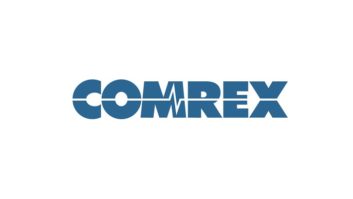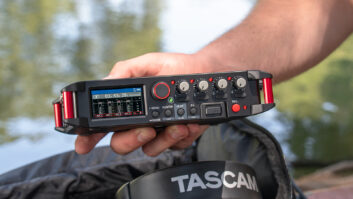Ethernet-based Audio Routing: A How-to Guide
Dec 1, 2011 2:00 AM, By Doug Irwin, CPBE DRB AMD

So the decision has been made to rebuild old studios, or to perhaps build anew. There are several ways to accomplish this goal, but for our purposes let’s say you are leaning towards an audio-over-IP system, even though you haven’t really selected the brand. To remove some of the mystery, I’ll look at the differences between the products of three manufacturers by designing a hypothetical radio station, and then seeing how the different systems fit in with our ideas about how we want this all to work. The basic specifications for the functionality of this imaginary radio station are outlined below.
Our theoretical radio station:
? Two identical studios, built as main and alternate main
? Either studio will be able to handle on-air duties including remote broadcasts. Either will be able to operate as an island unto itself on the air.
? All audio sources will be available in either studio or in the rack room.
? Some dayparts of this station use a combination of satellite audio and automation. During those dayparts, neither studio will be on-air. A mixer of some sort will derive the program, and feed the STL link.
? A legacy STL is fed by analog or AES.
? There are three remote sources: satellite receiver at the transmitter site, two in the rack room. Each needs its own mix-minus, routable from either studio.
? Each studio has a telephone hybrid.

Figure 1. Proposed station architecture. Click to enlarge.
Figure 1 shows the proposed architecture. They are identical with respect to recording and playback, and the automation system is dedicated to its studio. A studio computer records and edits audio, and retrieves audio via the Internet.
Either studio can be selected for the input of the STL switcher, which resides in the rack room. A mixer (real or virtual) is in the rack room to feed specified dayparts of automation plus satellite audio to feed the STL switch.
The router feeds both station STLs, but we’ll assume copper from both air studios so that, in the very unlikely event of a core switch failure, the station won’t be knocked off the air.

Figure 1b. The proposed rack room. Click to enlarge.
The rack room also contains two local sources for remote broadcasts; both are duplex links that require a mix-minus feed coming from one of the two studios. Obviously those feeds need to be routable, because one person could be doing an on-air shift in one studio, while a remote broadcast goes on in the other studio. Additionally, we have a source coming back from a remotely located satellite receiver that lives at the transmitter site.
Let’s investigate ways to build this system based on real hardware.
– continued on page 2
Ethernet-based Audio Routing: A How-to Guide
Dec 1, 2011 2:00 AM, By Doug Irwin, CPBE DRB AMD
Solution: Wheatnet E1
Both studios are built as shown in Figure 2. The heart of each is the Wheatstone E1 console, in conjunction with what Wheatstone refers to as the console blade, which in this case is the ip88cb. The ip88cb and the E1 are connected with an edge switch. Our requirement for three mics requires (at least) one outboard mic preamp since the ip88cb has two built-in. Both the playout system and the studio computer are interfaced to the Wheatnet IP System by Ethernet and the appropriate software drivers. (Both have dual NICs so they can be accessed on either VLAN.) This single Ethernet connection handles both audio and control. The CD players are connected to the ip88cb by AES3. Control is via GPIO.

Figure 2a. Click to enlarge.
The analog inputs (with the exception of the mic inputs) and AES inputs connect to the ip88cb with RJ-45 connectors, so an interface cable to go from RJ-45 to XLR is called for. These can be made in-house, or prefabricated versions from StudioHub can be used. StudioHub can also provide the logic break-outs as well, since they also appear on the ip88cb as RJ-45 connectors.
Legacy program outputs and the control room monitors are available via XLR connectors on the ip88cb. Headphone outs and cue amp outs come out via 1/4″ TRS.

Figure 2b. Click to enlarge.
Figure 2b shows our requirements in the rack room can be accommodated by a Wheatstone ip88a, which is another blade, with analog ins and outs. (This could just as easily have been an ip88d, by the way). Normally the STL input switcher is fed by an output of the ip88a, but in the unlikely event of a core switch failure, the switcher will take a legacy feed from either studio. The ip88a also accommodates the needs of the two codecs, making their audio feeds available anywhere on the network. It does the same thing for the satellite audio that comes back from the transmitter site.
Figure 2b shows our requirements in the rack room can be accommodated by a Wheatstone ip88a, which is another blade, with analog ins and outs. (This could just as easily have been an ip88d, by the way). Normally the STL input switcher is fed by an output of the ip88a, but in the unlikely event of a core switch failure, the switcher will take a legacy feed from either studio. The ip88a also accommodates the needs of the two codecs, making their audio feeds available anywhere on the network. It does the same thing for the satellite audio that comes back from the transmitter site.
The core switch handles multiple VLANs, one of which is for the office LAN, and one of which is for the Wheatnet segment. I make mention of that because it is important to note that Wheatnet can run on the same switch as an office LAN, as long as VLANs are used appropriately. This goes for the edge switches as well.
Configuration of the system is done with software Wheatstone calls Navigator. This will run on a PC that has access to the network that the various Wheatnet elements reside upon.
– continued on page 3
Ethernet-based Audio Routing: A How-to Guide
Dec 1, 2011 2:00 AM, By Doug Irwin, CPBE DRB AMD
Solution: Logitek Pilot

Figure 3a. Click to enlarge.
Figure 3 shows our system configured with a Logitek Pilot. The heart of each is the Pilot control surface, integrated with the Jetstream Mini (via RS-485), which performs the mixing and routing functions. With the Jetstream Mini, plug-in cards are specified to get the functionality that is needed. In this case the Jetstream Mini would require a microphone input card (that has four mic inputs); two of the four-input AES cards; and two of the four-output cards (analog or AES). The interfaces for these cards are RJ-45 connectors on the rear apron of the Jetstream Mini itself, so cabling interfaces are required. (Again, make them in-house or buy them prefab.) The GPIO connectors on the back of the Jetstream mini are DB15F, so you may need to plan to build out those connectors as well.
In this example, both the playout system and the studio computer are interfaced to the Jetstream Mini by Ethernet and the appropriate software drivers. (Both have dual NICs so that they can be accessed on either VLAN.) One Ethernet connection then handles audio and control.

Figure 3b. Click to enlarge.
Figure 3b shows the rack room setup with another Jetstream Mini accommodating our design. Three remote sources come in, one being the satellite audio returned from the transmitter site via the TSL. The Jetstream Mini would be used to mix the satellite audio with either the studio A or studio B playout systems (via network routing) for certain dayparts so that both studios can be off-line during those periods. Obviously that makes the studios available for other uses, or maintenance windows. An output of the Jetstream Mini is used to feed the input to the STL switcher, but the legacy feeds are available to the STL switcher just in case something should happen to the core switch that knocks out the LAN (and therefore the audio routing).
The other two of course are the remote broadcast devices – an IP codec and an ISDN codec. Their send/receive needs are serviced by the Jetstream Mini.
The core switch handles multiple VLANs, one of which is for the office LAN, and one of which is for the Jetstream segment. I make mention of that because it is important to note that Jetstream can run on the same switch as your office LAN, as long as VLANs are used appropriately. This goes for the edge switches as well.
– continued on page 4
Ethernet-based Audio Routing: A How-to Guide
Dec 1, 2011 2:00 AM, By Doug Irwin, CPBE DRB AMD
Solution: Axia Element
Figure 4 shows our setup with an Axia system. The Element control surface works in conjunction with the PowerStation. The PowerStation has two mic inputs, so the third mic needs an external pre-amp, the output of which would drive one of the analog inputs of the PowerStation. Three CD players are connected by their analog outs; GPIO is used for their control. Headphone outputs as well as the studio monitors are driven from analog outs of the PowerStation. The legacy output for the rackroom feed could be analog or AES. Connections are made on RJ-45 connectors.

Figure 4a. Click to enlarge.
Axia uses a proprietary protocol running over Ethernet called Livewire. Devices that support Livewire are physically connected to the system (for their audio and control) through this Ethernet connection known as a Livewire port. While it is completely feasible to use equipment that does not have the Livewire support (AES outputs, for example), in this particular example I’ve put one device in with it: the telephone hybrid. Via its Livewire port, this device gets its appropriate mix minus feed, and returns the caller audio back to the network as well.
In this design the playout system is connected to the Axia network via a set of software drivers that are installed on it. For this reason it needs to have an Ethernet connection to the PowerStation. So that it can be accessed by the station LAN as well, it has a second NIC connected to the LAN via a homerun. The studio CPU is configured similarly.

Figure 4b. Click to enlarge.
An Axia analog node is installed in the rackroom, and one of its outputs is used to drive an input of the STL input switcher. Sources would be mixed virtually and come in to the analog node via the network. A legacy feed from either studio is available in the unlikely event of a network failure. This same node services the needs of the ISDN codec, as well as the IP codec. Potentially you could install an IP codec as well as an ISDN codec with Livewire ports; in that case they would be connected to the Layer-2 switch directly. This is shown as alternative means in the Figure 4b.
Configuration of this system is done via Pathfinder software running on a PC attached to the Axia network. Again, if you need outside access, that same computer will also need an additional NIC so that it can also be on the office LAN.
– concluded on page 5
Ethernet-based Audio Routing: A How-to Guide
Dec 1, 2011 2:00 AM, By Doug Irwin, CPBE DRB AMD
Layer-2 switch considerations
Clearly you should pick a switch type and brand after consulting with the AoIP vendor that you choose; each will be able to recommend certain models, certified to work in their particular systems. If your intent is to use multiple VLANs then you will need managed switches. If you maintain a ready spare, make sure you save all the switch configurations, (after the system is up and running) so that the spare can be configured properly should it need to be used.
Irwin is transmission systems supervisor for Clear Channel NYC and chief engineer of WKTU, New York.
December 2011
Backstage at A Prairie Home Companion, a look at Ethernet-based audio routing systems, details of MPLS networks, and Field Reports on the Orban Optimod-FM 8600 and Harris PR&E Netwave….







